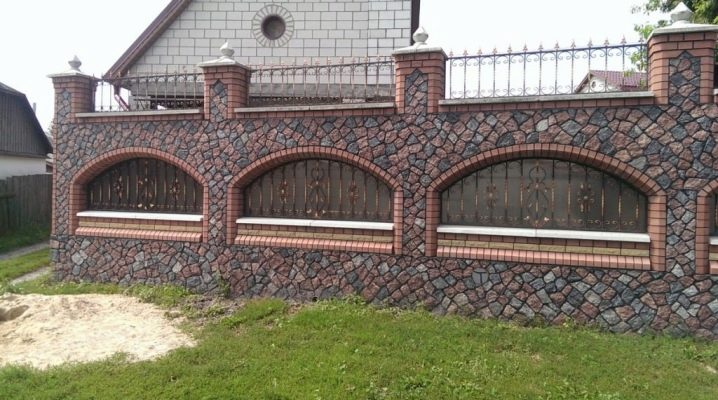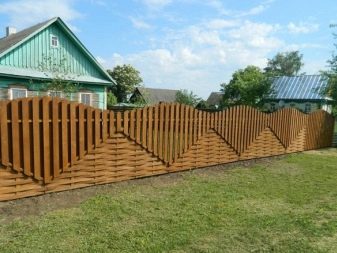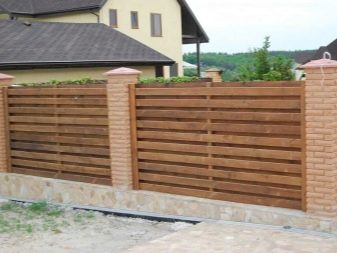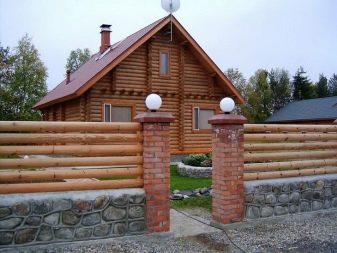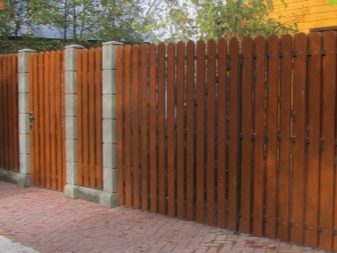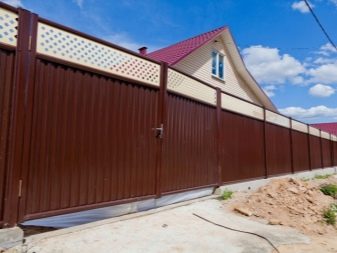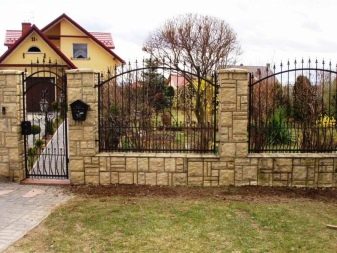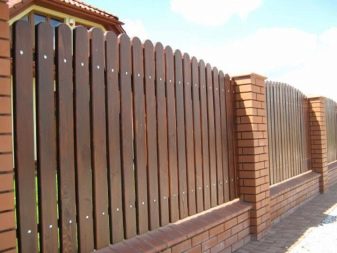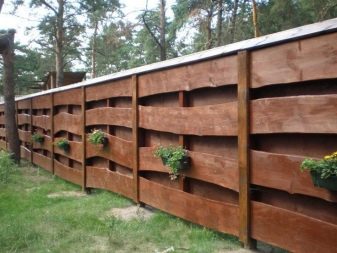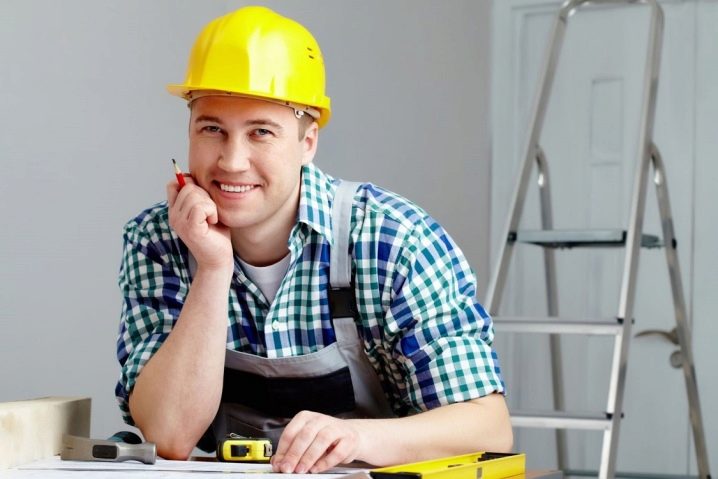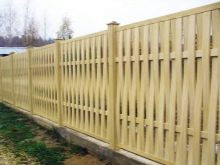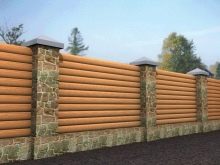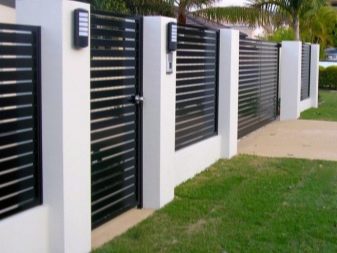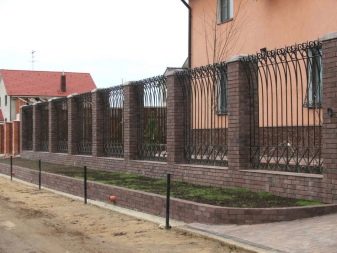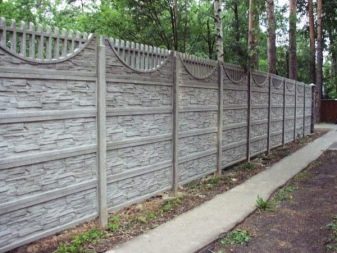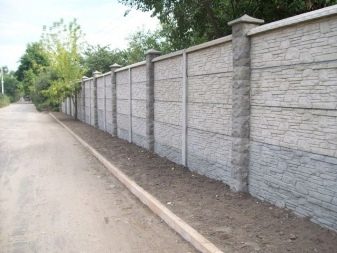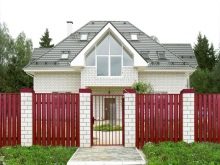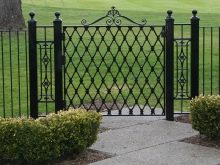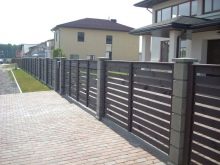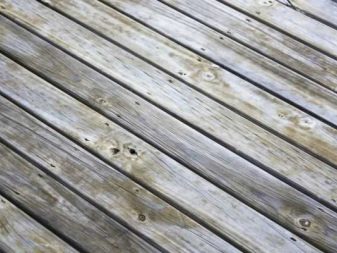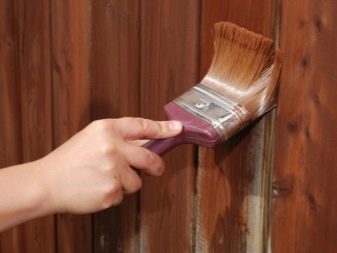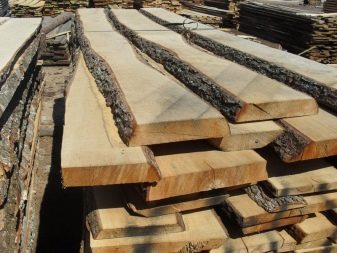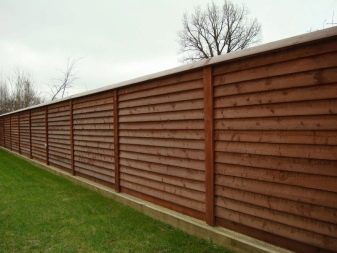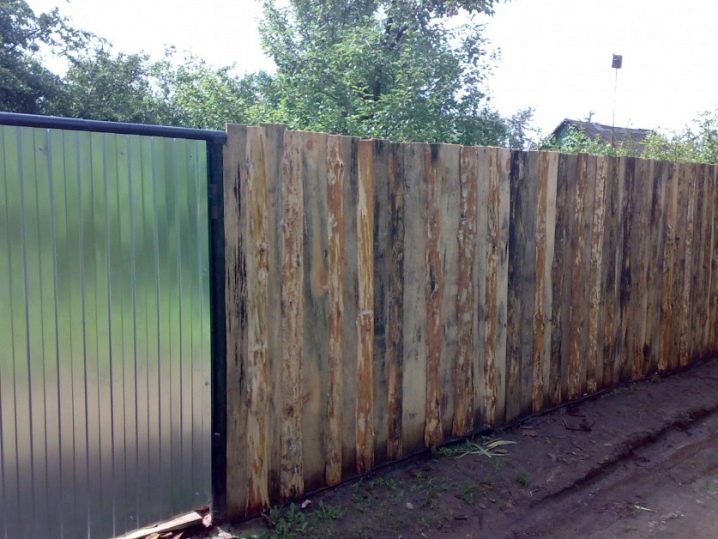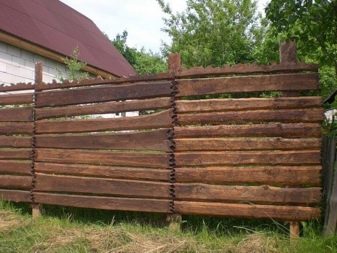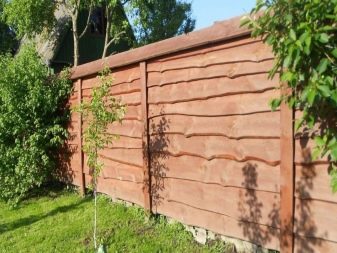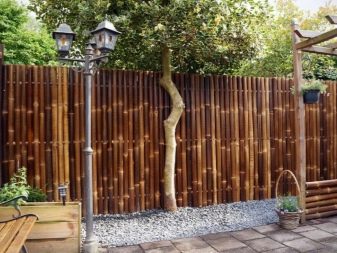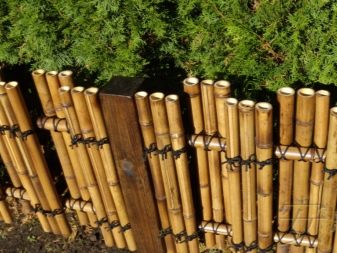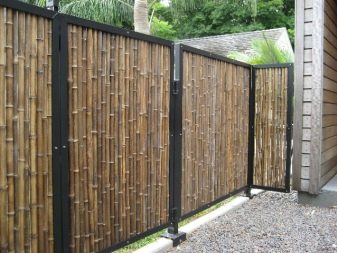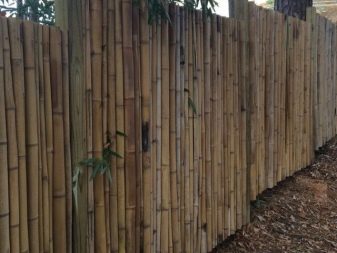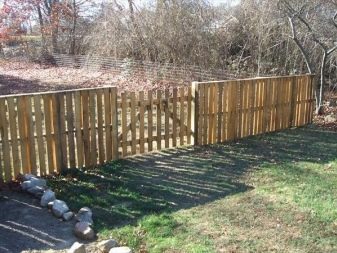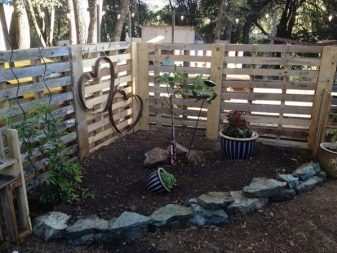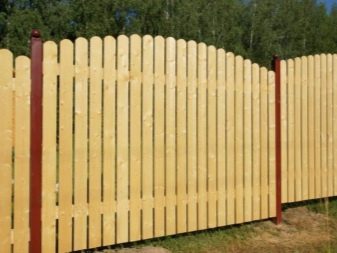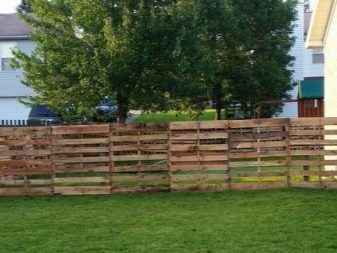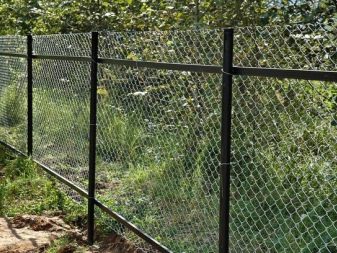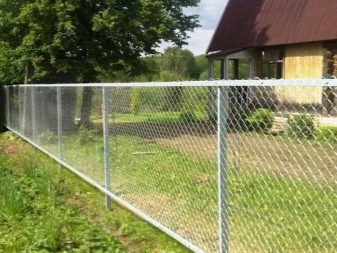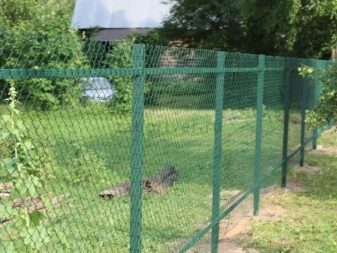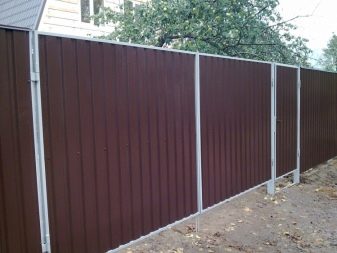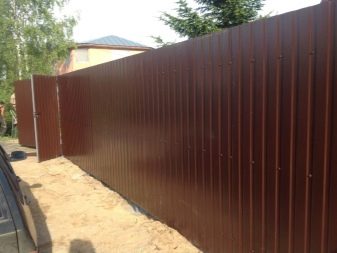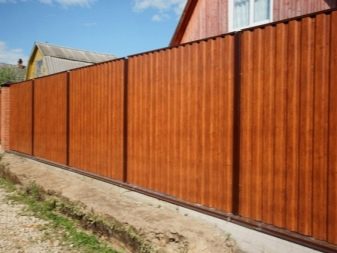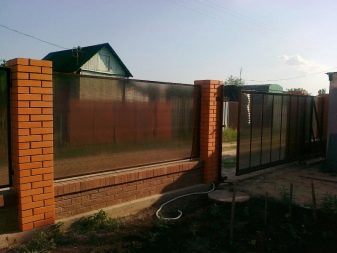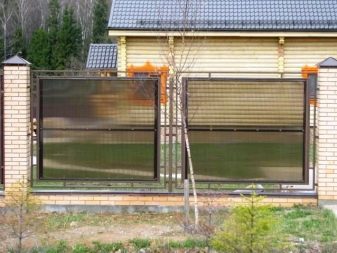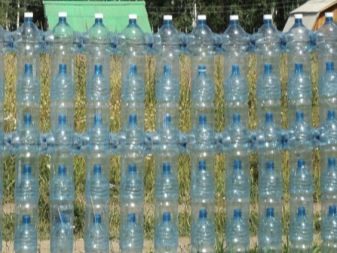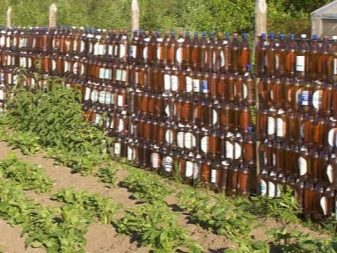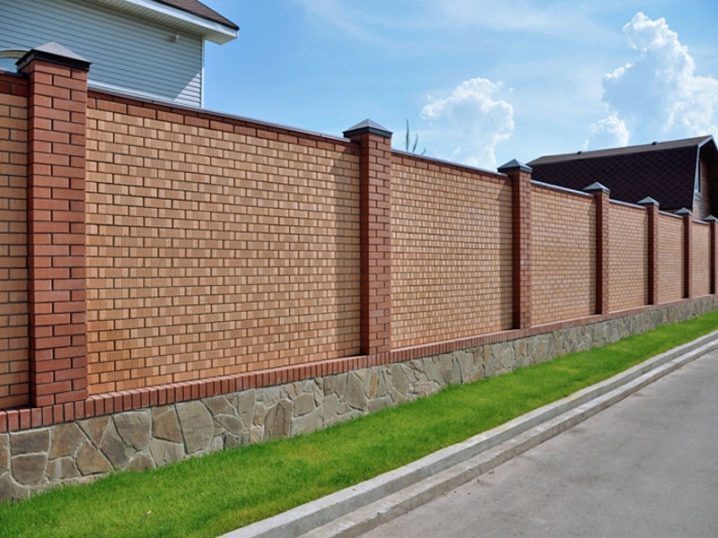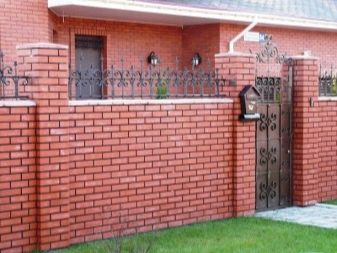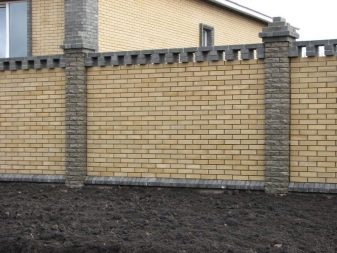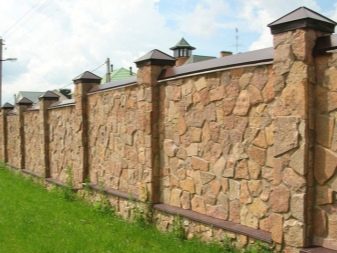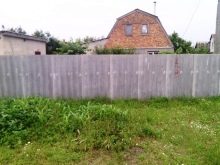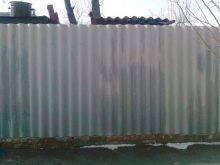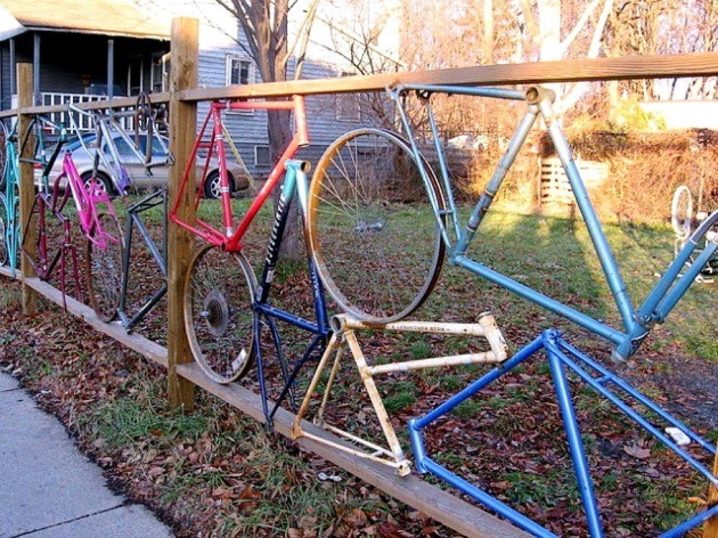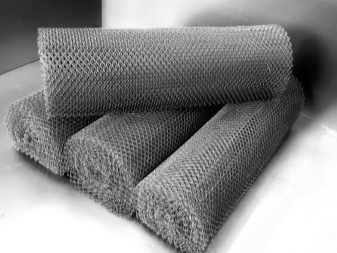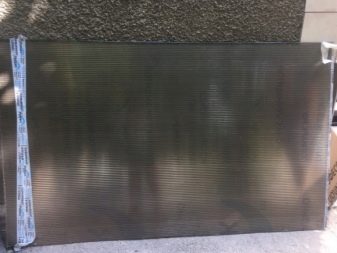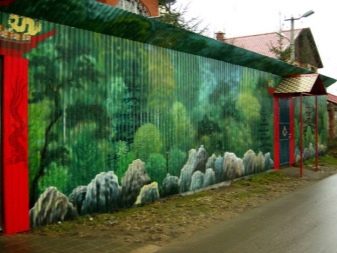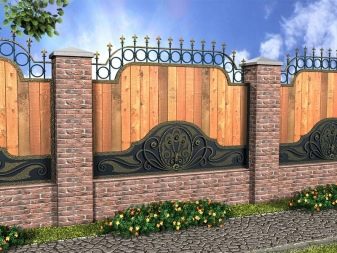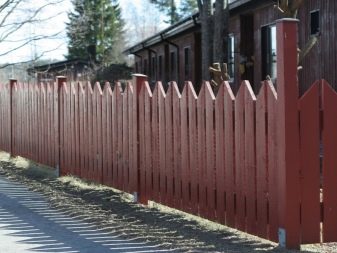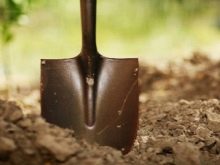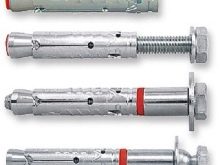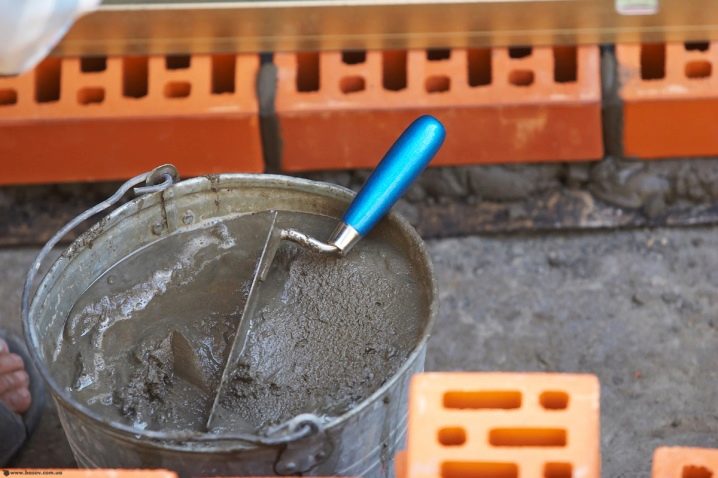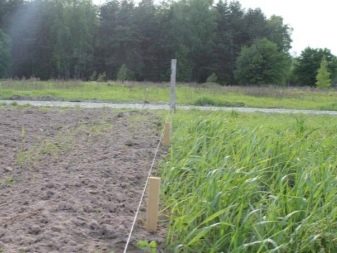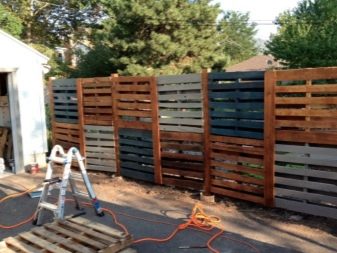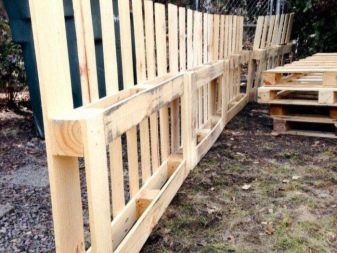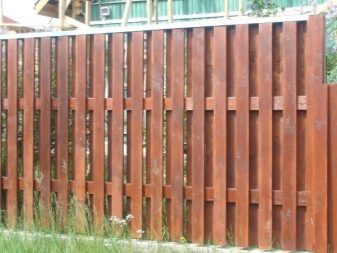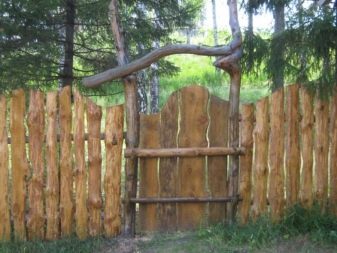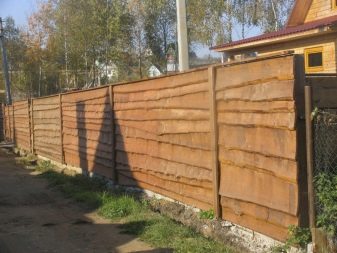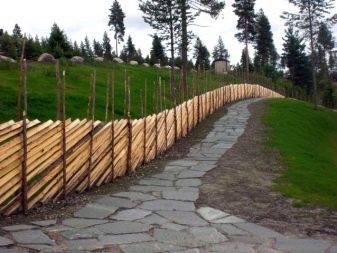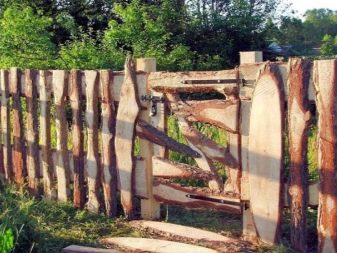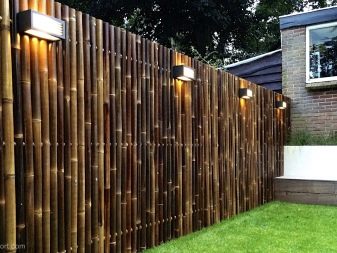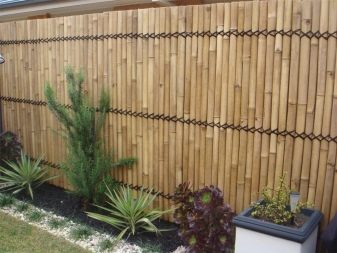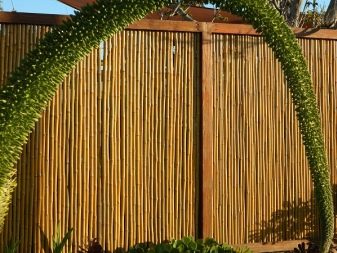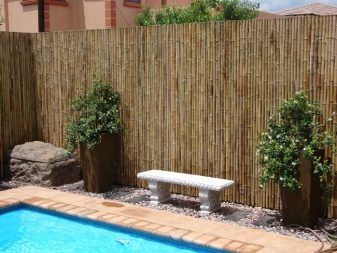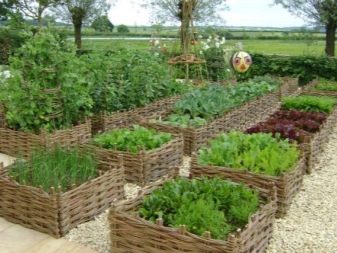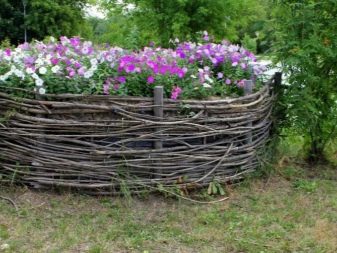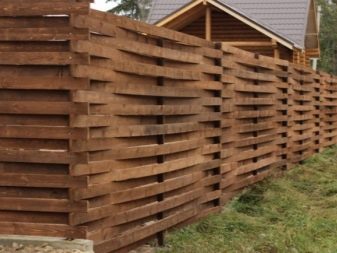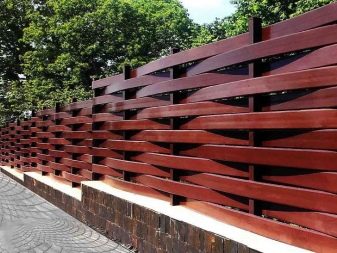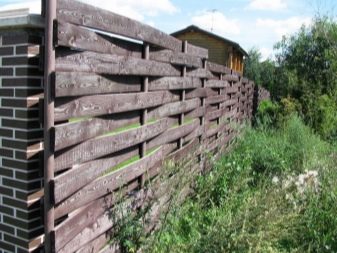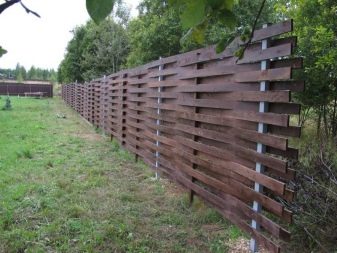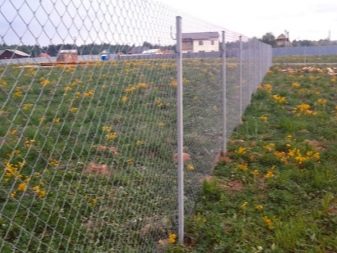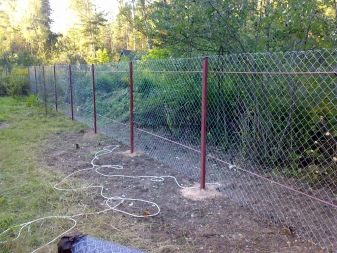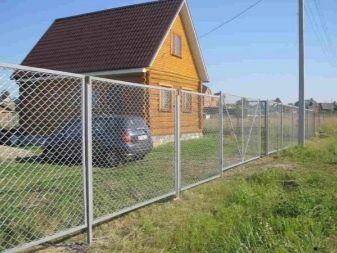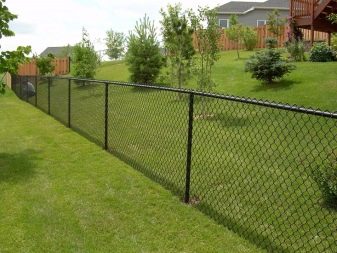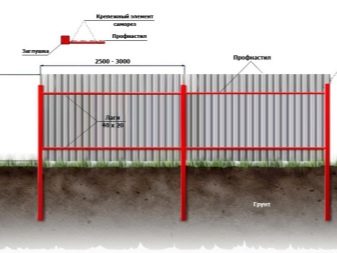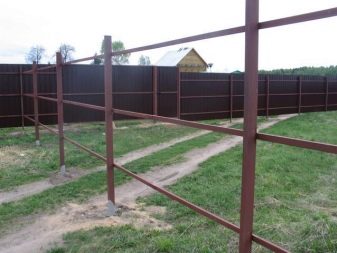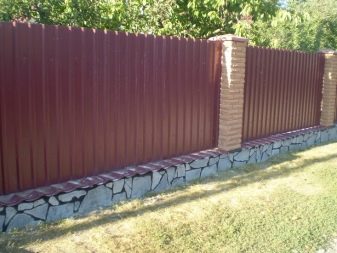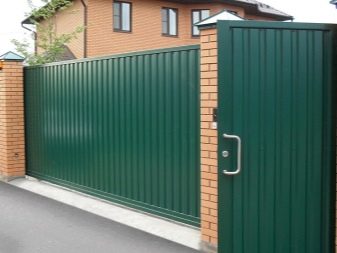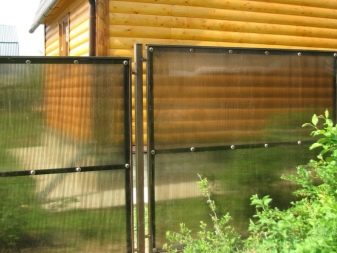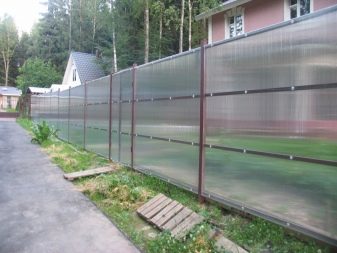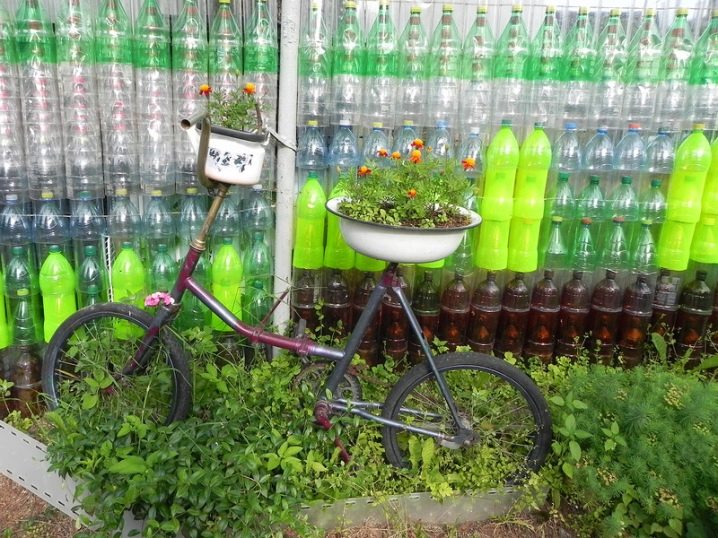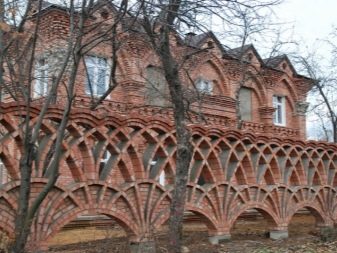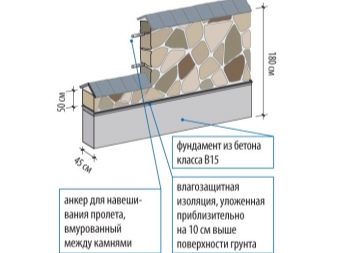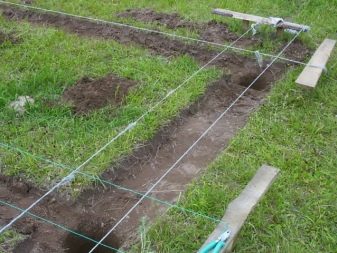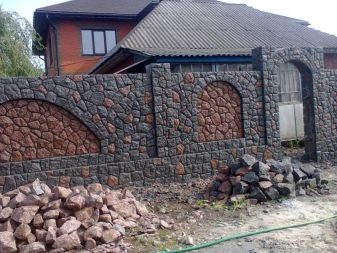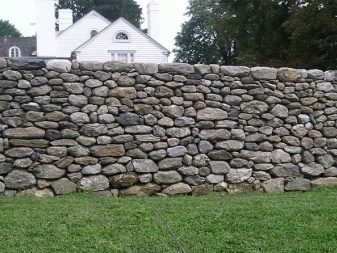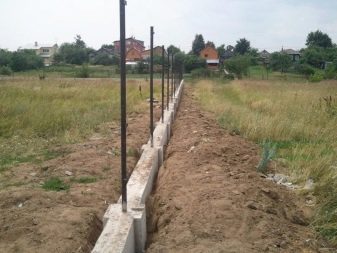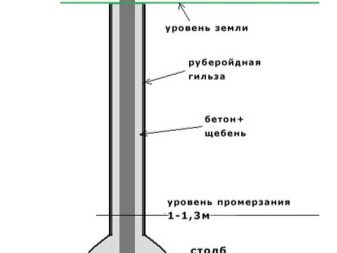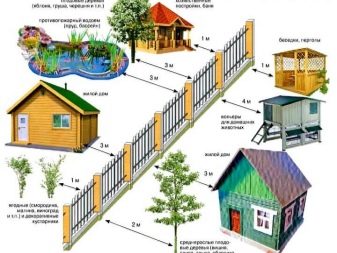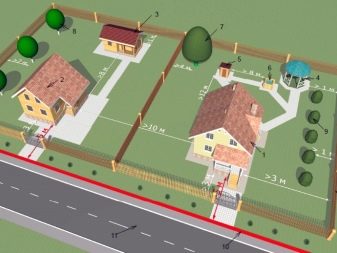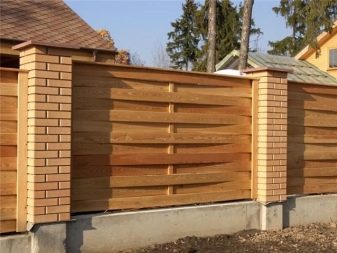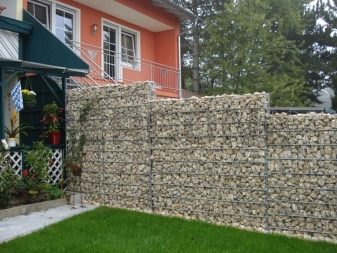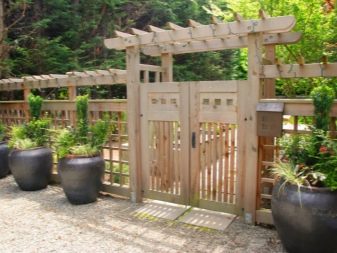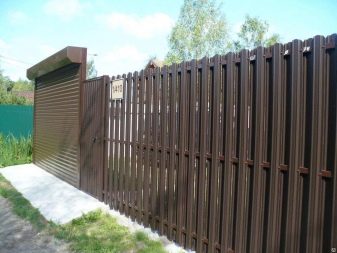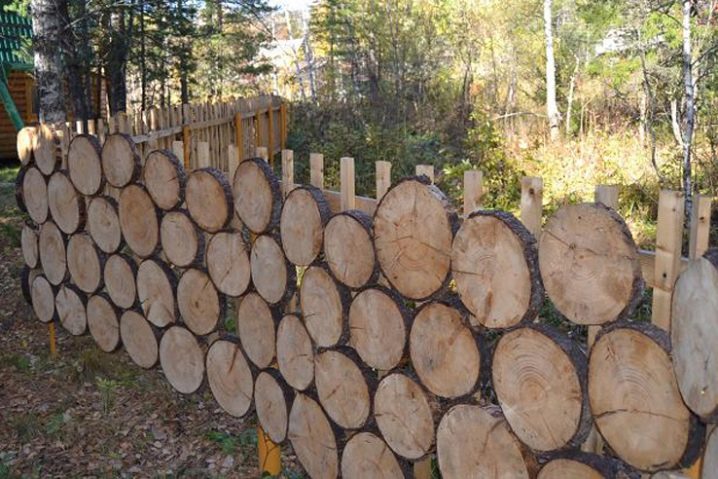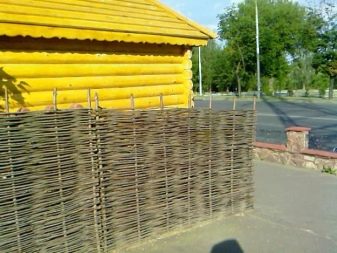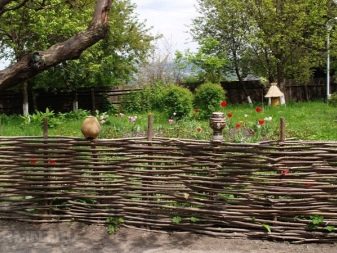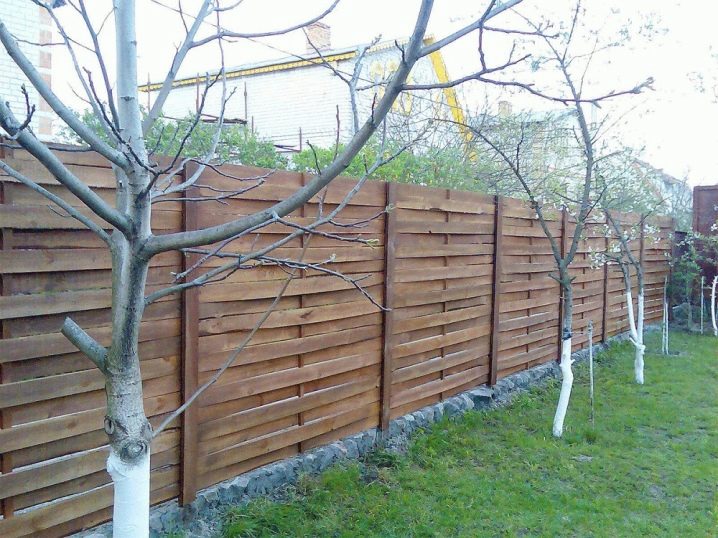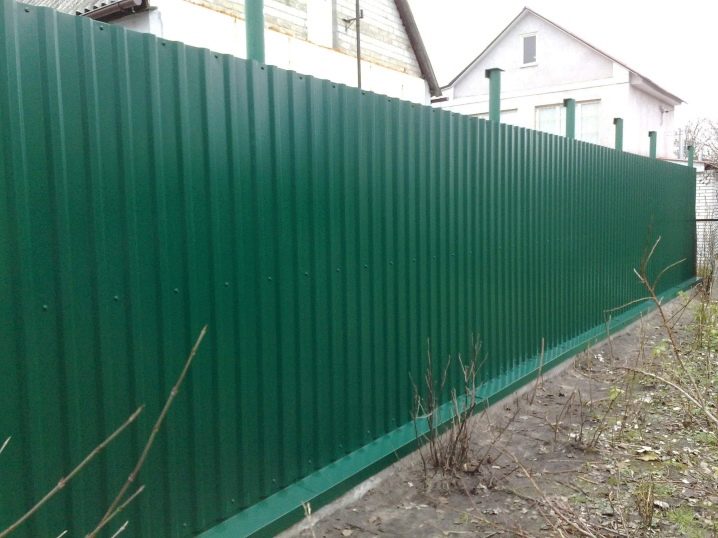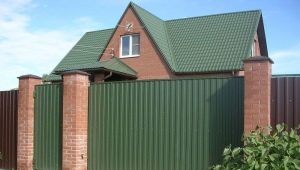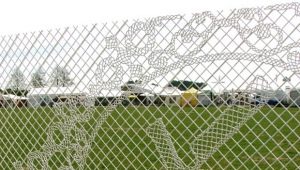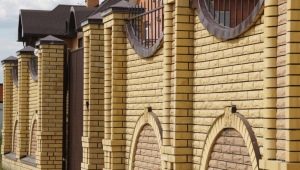Construction of the fence and its design ideas
Many who undertakes repair of the private house and the adjacent territory, think of how to save. One solution may be the independent construction of the fence.
There are plenty of ideas on how to build and arrange it.
Special features
It is well known that the fence performs several functions, regardless of where it is installed: between the backyard plots or between private ownership and the street.
- The first and main role played by the fence - protective. The fence is designed to protect the private area from prying eyes or intruders.
- The second function is aesthetic.. The fence should complement the exterior, combined with the surrounding landscape. Only then can it be called properly executed.
- The third function is a demarcation.. Regardless of how reliable the protective building, it visually separates one section from another, one object from another.
There is a huge choice of various barriers for every taste and color, but sometimes for some reason the landowner cannot buy or order a finished structure. This is partly due to the fact that he did not find the ideal option, but most often it is in the financial component. Finished fences are expensive, and with the installation - and even more expensive. Then the owner may come to mind the idea to build a fence with his own hands.
In addition to the relatively low prices, homemade fences have another feature - a limited choice of materials. This is explained by the fact that rarely at home you can find the same equipment that is used in large factories and enterprises. We have to be content with what we have.
Advantages and disadvantages
The idea of building a fence with his own hands from scrap materials has both advantages and disadvantages.
The advantages of self-manufacturing fences include:
- low cost of intake facilities - savings on materials and work are achieved;
- great variety - you can make a variant of any shape and appearance, everything is limited only by the imagination of the manufacturer.
There are disadvantages, but they still do not outweigh the benefits:
- increased time and labor costs - for someone who does not like to tinker with the repair, the construction of such a device will seem a difficult undertaking.
- need for preparation - you need to create an approximate sketch, draw up an exact drawing of the future fence, calculate a certain amount of materials, make a markup of the territory, prepare the foundation - in a word, do all the “rough work” that you don’t even think about at first.
If you want to create a fence yourself, then you must first study the fence device, installation rules, types of structures and similar nuances.
Kinds
There are many varieties of hedges that you can build with your own hands. An ordinary painted fence will not impress anyone. Barriers are made from a wide variety of materials. They can vary in size - height and thickness. An important role is played by the foundation for the fence, which is an indispensable component for a solid fence.
By and large, all fences can be classified into three large groups:
- vertical;
- horizontal;
- monolithic.
The first two varieties are made from slats, stacked either vertically or horizontally. Monolithic fences are made of solid web. There are also reticulated, forged options, but they fall into a narrower classification.therefore, they are not separated separately.
First you need to decide what kind of fence you want to install on your site. Should it be completely deaf, to let in a little light, or not to protect the area from prying eyes at all - the choice is yours. Once the decision is made, you can be determined with the material.
Material
Today there is an abundance of options from which to make a fence. There are models of concrete, brick, profiled sheet, forged gratings, stone, mesh, even ordinary plastic bottles - in short, of everything. However, it is extremely important that some materials are unsuitable for home-made fences.
So, a concrete example is concrete. Many have seen sectional concrete specimens, cast in molds with different decorative patterns that mimic the structure of natural masonry,vine drawing and the like. Speaking frankly, creating such a structure on your own will not work: the process is very laborious.
Another thing is that concrete is often used to make the foundation of fences. Such use can be called traditional. The only option of the fence is concrete, which can be made independently - this is a design on special glasses. However, it is mainly used as a temporary barrier due to poor aesthetic properties.
There are a lot of materials suitable for creating hedges with their own hands. Often they can be found at home or get almost for nothing, others will have to spend money. A common feature inherent in all options, is the ease of construction.
Difficulty can only cause welding work when they are necessary.
Tree
Wood is a common name for several dissimilar materials. First of all, you need to understand that all of them are united by advantages and disadvantages inherent in wood.
- Wood reacts poorly to changes in temperature, humidity and similar atmospheric phenomena. Under the influence of moisture, it swells, can be deformed.
- All wooden boards dry out and cannot be corrected by any treatment.
- The wood is prone to rotting, and it is often spoiled by various pests, for example, the bark beetle. To protect the surface, it is repeatedly treated with special compounds and paints.
- To work will not need some expensive equipment. As a rule, everything you need can be found in your barn.
- Unedged board is extremely plastic, not to mention the vine. This opens a huge field for experiments with the shape and appearance of fences.
- Wood is highly flammable, so this option can not be attributed to fireproof. However, if the building is located at a considerable distance from the house and the likelihood of a fire is minimal, then this option is perfect.
One of the most often created are fences from slab. This is unedged board, which has cut only on one side, and on the other hand, it is either a semicircular surface or a partial cut. The bark from the croaker is not removed, and depending on the gingival coverage varies the price of it.
Less smooth options will cost less than relatively smooth ones.
The popularity of this material came with the advent of fashion on ecostyle. He is increasingly reflected not only in the interior, but also in the exterior. If it is laid out horizontally butt, then an illusion will be created as if you are in front of a fence made of logs.. This is used by many designers.
Due to the fact that the bark is not removed from the material, it is often subjected to damage by various insects. When working with slab, it is extremely important to pay sufficient attention to the preparation of the material, its processing. The bark must be removed and the bare surface must be primed, sanded, covered with several layers of varnish for greater reliability.. Please note that such a coating is better for wood than others, because it allows to emphasize its natural beauty.
Non-standard and unusual solution is the choice of bamboo stalks as materials. The appearance of this fence is extremely unusual, and the views will certainly be riveted to it. Before you establish yourself in your decision, you must keep in mind a few features inherent in bamboo stalks.
- The wood of this type is subject to strong desiccation, so that the stems must first be prepared to protect against excessive loss of moisture.
- If water gets inside the stalks, this will lead to an early deterioration of such a fence. It is necessary to come up with a solution that will protect their internal cavity from the ingress of water.
Bamboo fence is not always well combined with the landscape, because the material is quite exotic. If you are not sure that it will fit well into the situation, it is better to give up his choice.
Despite such ambiguous characteristics, it is easy and pleasant to work with such material. Obstacles are created from it quickly, but it is not worth waiting for a wide variety of options. Keep in mind that bamboo fences are usually made vertical, not horizontal.
The most interesting material from wood can be called pallets.. By and large, they are not material at all. Rather, it is ready-made designs. It should be borne in mind that for the manufacture of such pallets wood of tolerable quality is used. The small boards of which the pallets are made can be very good at all.
The advantage of pallets is that they can be used both intact and disassembled. A fence made of parts of pallets may be durable and beautiful, but the one-piece version will not yield to it. but in both cases the wood needs additional processing, although it was already processed in the factory.
Thus, the whole variety of materials from wood opens up a wide scope for imagination. You can choose an option for simple construction or choose more difficult, but show more creativity. It is necessary to coordinate the material and the surrounding landscape, among the wooden variations you can always find a suitable one.
Rabitz
Grid fences are often divided adjacent to each other areas, and all thanks to the characteristics of the chain-link. It is well transmitted light, while completely unable to protect the privacy of the owners from prying eyes. Available in several versions, however, for barriers is only suitable with a galvanized coating.
It protects the metal from corrosive processes, with the result that the metal does not rust and will last much longer.
To the grid you will need to purchase additional materials: metal profiles or pipes as pillars for fastening. And it will also be necessary to acquire thick wire and anchors to attach it to the pillars so that the bottom fence can not be bent.
The chain-link can be supplied with the expectation that it will serve to support a hedge of climbing plants. This option is cheap, while the result will be a spectacular and colorful fence.
Decking
Barriers made of corrugated are more common than others. The material is used not only for the construction of deaf fences for private houses, but also for fencing plots. To create a sheet fence, you will need a welding machine and some welding skills.otherwise the installation of such a barrier is extremely simple.
The advantages of such a fence include not only the ease of its installation, but also a huge selection of all sorts of decorative solutions. There is a material of different colors, glossy, matte, patterns are applied to them, if desired, with the help of airbrushing or other techniques.
Decking needs additional coverage. It will be necessary to re-process the material with an anti-corrosion agent.to protect it from rust. As an alternative to this composition, you can also use paint, only it will be necessary to apply it in several layers.
Often sheets processed according to the rules are shipped directly from the factory.To install the option of corrugated board, you will need additional materials: metal or wooden pillars-supports.
Plastic
To build a plastic fence, you can use several options for raw materials. In the first case, whole layers of polycarbonate are used. This material stands out against all others, largely due to its appearance. The panels are translucent, well transmit light, while distorting the space. Thus, excellent light transmission is ensured and the site is protected from unwanted views. Plates are monolithic or cellular. The choice in favor of a particular variety is determined mainly by the available budget.
The second option is less traditional, more creative and, moreover, much cheaper.
So, for the construction of the fence using ordinary plastic bottles. Making such a fence is fun and easy. Bottles filled with air have high strength properties and at the same time they are very light. A more unusual way to build a barrier is not to be found.
Such a fence will always attract attention, but if you choose bottles of cinnamon, green or other colors, the barrier will turn out to be opaque.
Brick
Brick is a versatile material suitable for the construction of both buildings and adjacent structures, including fences. Brick version will have the strength that some other fences so lacking.
Construction of a brick fence will require some time and effort, as well as the experience of the workerbut the result will exceed all expectations. Brick looks solidly, reliably, combined with almost all other materials, including with wild stone.
The quality of the fence is largely determined by the quality of the brick itself as a material. Builders advise to choose red, not white brick.if there is such an opportunity. Red is harder and stronger, and white is more aesthetically pleasing and combines with any environment.
Brick is also used to build a foundation for other types of hedges, such as forged. In this case, it is extremely important to pay enough attention to the choice of the mixture, as well as to allocate as much time to the hardening of the brick foundation as needed.
A rock
Self-made stone fences are more common than it might seem at first glance.Popular as a natural stone, and artificial. However, it is worth being prepared for the fact that the process of laying a stone fence is quite laborious. This is due to the characteristics of the material itself. Stones have jagged edges, unequal shape, making them difficult to join, and you have to resort to various tricks and tricks.
You can often find fences of the combined type, in which some part (or foundation, or the fence itself) is made of stone. The stone is durable and reliable, therefore it is suitable for both foundation and masonry.
The material varies in size, color, porosity and many other characteristics.
Slate
After-slate sheets can be re-installed, using them as a reliable and durable fence. Although in fact this material is fragile enough: it can easily go cracked. You should not expose it to various mechanical loads, and during forced transport it is better to secure as much as possible.
The main advantage of slate is that the fence will be well combined with the roof of the building. Such a complete match, as in this case, is incredibly difficult to achieve, so the original decision to use it for the fence is a winning one.From an aesthetic point of view, everything is not so simple. Someone will like this decision, but some will not.
Metal
As the metal parts for the fence itself can serve any ready-made welded elements, whether it be bicycle frames or headboards, frames of old beds. Everything will go into action.
If you liked any part of the old iron furniture, but you do not know how to use it, then make a fence - one of the best ways.
Dimensions
The size of the fence varies depending on what it is made from and for what purposes. For example, you can buy a few meters of "chain-link" or with a dozen sheets of polycarbonate. In these cases, and the thickness and height of the fences will be different. The width is determined by the perimeter of the territory to be protected. Distances are calculated immediately on the drawings.
Colors and design
There is a wide variety of design solutions for fences. This applies to both colors and textures, and drawings. They can be painted in various non-standard colors. They can put any interesting pattern or ornament.
One of the novelties is the possibility of photo printing.. It is performed mainly on sheets of corrugated board. The drawing is applied on a large area of the canvas, sometimes on the entire canvas, as a result of which you can get the original effect of being present in another place. For example, a house may be located in a wooded area, and a landscape with palm trees and a seashore may be applied to the fence.
Popular and hand painted. It is usually applied to wooden vertical fences to make them look a little more interesting. As a basis they choose both abstract ornaments and quite specific motifs: images of animals, flowers and the like.
The fence can be either straight or wavy, ribbed, forged. Differently make out and its upper edge.
So, it can be convex, concave, with peaks, pins or other shapes.
Necessary tools and mixes
To complete the construction of the structure, additional tools and fittings may be needed. In addition to the obvious tools, such as a shovel for digging holes for the foundation, a screwdriver for installing self-tapping screws and others, you will need specialized ones designed to work with a certain material.
For example, choosing a professional sheet, you need to think about how to cut it, how to install fasteners. You may need anchors or other additional items.
As for the mixtures, then solutions for processing materials will be useful first. It is necessary to apply the solutions in order to protect the details of the future fence from the negative effects of the external environment, to prevent corrosion or rotting.
Also, in all cases, need a cement mortar or cement-sand mixture. The ratio of sand and concrete, as well as the required grade of concrete is determined for each case separately. It is necessary to make the mixture strictly according to the instructions indicated on the package, otherwise the strength properties of the entire erected structure may suffer.
How to do it yourself?
There are many options, each of which requires an individual approach. At the very beginning of work it is necessary to remember two things: it is safety precautions and regulatory requirements for fences. Be sure to familiarize yourself with the SNiPs governing such construction activities.
Before you start making the fence with your own hands, it is necessary to mark the area in accordance with their drawings.. Do not forget to check if there are any communications underground. For example, before hammering an iron pile into the ground, you need to make sure that high voltage cables are not laid just below. If such a test was not carried out, and the cable really turns out to be in the same place, then you risk not only de-energizing the entire area, but also losing your life.
You should consider the scheme of construction of fences of these or other materials in more detail. After studying the question in detail, you will be able to independently choose the right option, correctly carry out the preparatory work, to lay the foundation in accordance with all requirements.
Wooden
To build a wooden fence is quite simple. There are several ways to do this:
- use pallets;
- make of boards.
Both options deserve attention, since their construction does not take much time and effort.
Construction from pallets is extremely simple. Finished pallets simply connect with each other without disassembling pallets.. It turns out the barrier height of about one meter. Usually, such a height is sufficient, since fences of pallets are not used as the main barrier structure.
The option of the boards can be varied in height. Usually such a fence is made vertical and deaf, however, it may be horizontal. It is extremely important to lay the boards a little overlap (2 cm), because over time the material shatters, and to ensure privacyit is necessary that the fence still completely covers the site.
Both wooden and metal poles can be used as supports. note that piles of wood need additional processing and waterproofing. Since the fence will not be too heavy, it is not necessary to do the fortified foundation - it is rather ordinary.
From croaker
The fence from production waste - slab - is erected in a similar way as from ordinary boards. The croaker is more susceptible to drying, therefore it is extremely It is important to treat it with a special moisture-proof impregnation after the surface has been cleared of bark..
Please note that it is not necessary to choose material with a perfectly flat surface for the fence. Knots and other shortcomings, primed, processed properly, can be turned into dignity by making a fence in accordance with eco style.
After erection, the fence can be painted, although designers strongly advise to do without it. The texture of the tree and the interesting shape of the slab themselves are quite decorative. The same goes for the top edge. It is not necessary to round it up or make it shaped.
Do not forget to overlap the boards to offset the effects of shrinkage.. Remember that the slab looks best when a vertical fence is made of it, because this is the way to achieve the most complete illusion of a good log fence. The supports can also be decorated with boards of slab. This will complete the picture.
Bamboo
Bamboo fences - a real exotic. They can be reliable or not. Often bamboo shields framed with metal frame, welding it in the corners in order to make the structure more resistant to different kinds of impacts, both mechanical and weather.
Occasionally, ordinary twine can be used to bind bamboo stalks, but this option is not the most reliable: in the winter, the ropes may burst. This does not apply to situations where a bamboo shield was bought with a roll already with twine. As a rule, factory samples are specially treated.
Difficulty may arise from how to close the stems from the top of the penetration of moisture. To find an aesthetically correct, cheap and at the same time simple solution is easy enough. Here you can use an ordinary board, slightly wider than the width of the stems. The board is laid on the stems flat and fixed at the pillars.
For the horizontal fence such a measure is not needed. Keep in mind that for supports or horizontal bars it is best to choose the same bamboo stems, although you can give preference to metal. Do not forget to process all the details of the design with a special antiseptic..
Wicker
Surely wicker fences at least once saw everyone. As a main barrier, the fence has not been used for a long time, but exceptions are always encountered. Basically, weaving is chosen for the isolation of flower beds, flower beds, as well as just for styling a particular corner of the garden.
The wattle fence is created both from twigs, and from thicker and sturdier branches.. A small fence can even build a child. It is important to pay attention to the rods are flexible and pliable, but at the same time durable: they must be hard to break: it is best to choose for the construction of fresh branches. Last year's will also work, but they will need to be pre-soaked. It is preferable to give preference to alder, willow, and birch twigs, since they are at the same time both flexible and strong to break.
Particular attention to the base of such a fence. Racks are driven into the ground at a distance of 50-60 cm from each other, depending on the thickness of the rods. The supports can be both wooden and metal. Please note that in this case the pitch between racks is several times smaller than usual.
An alternative way to make a wicker fence is to make it from boards.
The implementation of this option is somewhat complicated by the fact that the boards are not as flexible as the rods, and it can be difficult to bind them. The result will fully justify the efforts: the fence will look good and impressive.
Particular attention should be paid to the supports, as they have several specific requirements. First of all, racks must be made of metal. This is due to the fact that they are subjected to high loads, since the pressure of the boards is great. Secondly, such piles are always cementedso that they do not break out of the ground, do not change their vertical position.
After the construction is completed, the entire structure is painted to additionally protect it from the negative effects of the external environment. It is important to use paint, not varnish.so that metal piles are not knocked out against the background of the overall composition and are invisible.
From the grid
This option is considered one of the most economical. Its popularity is partly due to this. Rabbit fences are durable, resistant to temperature extremes and other weather conditions, they are easy to install and unpretentious to maintain. Grids are presented in a huge assortment both in color and in cell size. It is this variety that makes the rabbit unique, because you can choose an option for any need.
In this case, it is best to use metal poles that are concreted when embedded in the ground.. Fasteners will be required, since the chain-link netting cannot be fixed on the screws.You can also use a twine if it is a question of erecting not a protective fence, but simply a separating one.
To prevent the mesh from folding so easily underneath, use thick wire.. It is passed through the cells and stretched between the pillars of the base, securing with the help of anchors in a tensioned state. This decision makes the site more difficult for thieves, also does not allow stray animals (including wild ones) to stray here.
It is not necessary to process the mesh, as the galvanized version is already fully prepared for installation.
From a professional flooring
The undoubted advantage of building a fence from a professional sheet is that you will not need to make a preliminary drawing. All that is needed is to mark the position of the fence, mark where the gate will be, and install beacon pins right at the site where the support pillars are installed. The step between them should be 280-300 cm, depending on what wind load the fence will be subjected to.
The more windy the terrain, the more often the supports should be.
The bottom of the pits for the pillars must be reinforced with rubble or gravel. The fence from a professional flooring weighs a little, but also it is a lot of, therefore it is necessary to protect it from a subsidence. Racks must be installed vertically.by checking their location level. Otherwise, the fence will quickly skew and collapse. Horizontal bars - logs - should also be metal.
All work is performed by the welding machine, with the exception of the fasteners of the sheets themselves. They need to be fixed with screws, laying sheets overlap. Mounting step is 15-20 cm.
Plastic
For the construction of polycarbonate fence, as well as for the option of corrugated board, the plan is not needed. It is necessary to mark the territory, mark the position of the gate, on the borders of which it is necessary to install strong pillars. Supports put and in the corners of the future fence. Next, the piles are fixed at a distance of 250-300 cm from each other. They are connected to each other using horizontal crossbars. In conclusion, fasten the polycarbonate panel.
It should be borne in mind one thing. When choosing support pillars for polycarbonate intake, preference is given to options with a square cross section.. This ensures a more tight fit of the plastic panels to the supports and they will be fastened better.
Another option is to build a fence of plastic bottles. To do this, they cut off the bottoms, and the bottles are inserted one into another until the desired height is ensured. Such strips of bottles are fastened together with glue to make shields. In the future, the shields are attached to the supports.
Keep in mind that such a fence is more decorative than protectivetherefore, installing it as a street is not worth it.
Brick
To lay out a brick fence at home with your own hands, you will need at least a little experience in the construction industry. Laying only at first glance seems simple. In fact, this event requires considerable skill, and this is due to the unpopularity of such improvised obstacles.
First you need to decide on the thickness of the fence. It can be laid in one or two bricks.. But you also need to think about the laying itself, what it will be. Bricks can be laid out one above the other in a checkerboard pattern (this laying provides the greatest strength), as well as crosswise. The latter method is used in the construction of double fences, when the first layer of bricks is laid along, and the second across and layers alternate.
Cement mortar must be of high quality, prepared in an optimal proportion.
Do not use expired mixtures.: their adhesion is greatly reduced, so there is a risk that the whole structure will collapse soon.
To learn how to build a brick fence with your own hands, see the next video.
Stone
Stone fence can rightly be called the most durable of all. If you put it right, then he is quite able to stand for more than one century. For the construction it is necessary to make a preliminary drawing, in which note what will be the height, thickness and width of the barrier, where to allocate space for the gate. Then mark the site directly with stakes set in the corners, and a rope stretched between them.
The construction of the fence begins with the installation of special forms of plywood along the marking lines. Spread stones inside this construction, then wait for the cement mortar to set, and only then remove the mold. This ensures the evenness of the sides and corners of the stone wall, which is especially important when building stone columns or pillars.
Stones can be selected so that the cement joints are visible well or completely hidden from view. The filling of the fence also varies: you can just pour the cement mortar, laying out the stone only on the outer sides, and you can create a fence completely stone.
Tips and tricks
Master builders willingly share tips on how to properly build a fence, so that all the work went as smoothly, quickly and easily as possible.
- Never neglect the foundation for the fence. You can refuse it only if the fence is temporary. It is absolutely impossible to remove the base: in spring, the hedge can squint, deform, or even collapse.
- The depth of the instillation of supports should exceed the depth of soil freezing. Usually this value is 100-150 cm, so you need to dig deeper piles.
- It is not necessary to proceed to the next stage of construction work, if the previous one has not been fully completed. For example, it is not necessary to move on to laying the next layer of cement, if the previous one is not yet dry. The only exception may be works where strict adherence to this rule is not necessary and this has been stipulated in advance.
- Do not proceed to the construction of the fence, if you have not checked with the norms of SNiP.
All fire regulations, as well as the permissibility of installing a particular structure between adjacent sections or on the street, are described there.
Reviews
Most people speak positively about their experience in building improvised intake structures. Most often, simple options were chosen such as fencing from corrugated board, chain-link mesh or others. There were also cases when a time-consuming option was chosen: stone, brick, wicker from boards.
The greatest difficulties arose with the laying of the base. It was necessary to create it perfectly smooth, so it was necessary to check the building level every now and then. It was also not easy to properly pave the waterproofing. Someone used ordinary resin. These people noted that the result was not worse.
For many, the work was complicated by weather conditions. With dryness and heat, the concrete dried out too quickly, unable to gain strength, as a result of which it cracked. When it rained, on the contrary, the composition did not dry out at all. Therefore, it is advised to carry out the work at the end of April and May, when the weather is best suited for construction.
Interesting examples and options
Below is a photo gallery of examples of how a home-made fence, built in the country or in a private house, can transform the surrounding landscape.
Unusual design create a rare form of lumber. In this case, the round cuts are chosen, and the bark on them is preserved. The fence rather serves decorative purposes.
Wicker fence looks distinctive. It is well combined with a log house, but contrasts strongly with the street. These options are best to choose for country buildings.
A wicker plank version is both traditional and unusual. It looks solid and reliable, it does not make the landscape heavier visually.
It is quite easy to build a fence from a professional sheet, you only need to correctly calculate the width of the step between the supports, as well as select high-quality materials.
Lacquered wooden fence creates an atmosphere of comfort. At such a site, you really feel at home and under protection, while the barrier well passes light and air.
